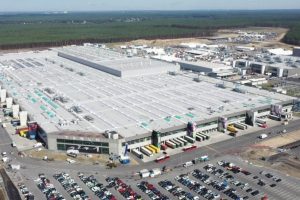Tesla (NASDAQ: TSLA) reported its earnings for the first quarter of 2023 last night, and analysts kept a close eye on margins as price cuts continued to plant seeds of uncertainty in their minds.
Analysts were fixated on the 20-plus-percent margin level and whether Tesla’s strategy of cutting prices to undercut competitors and make its vehicles more affordable would hurt the company’s balance sheet.
While automotive gross margin came in at 19.3 percent, with Wall Street expecting 20.7 percent, analysts like Dan Ives of Wedbush highlighted that the price cuts were used to “further stimulate consumer demand in a shaky macro amidst rising EV competition globally in this EV arms race.”
Tesla called its drop in operating margins “manageable” as it expects to rebound through improved production efficiency at its newest factories, as well as lower logistics costs and scaling. Its factories in Texas and Berlin have ramped up production rates on several occasions thus far in 2023 already, and as manufacturing continues to grow at those factories, Tesla will also increase its annualized build rates with a new plant in Mexico.
Wedbush is still bullish on Tesla long-term, and its “near-term margin pain for long-term demand/volume gain” is something Wall Street firms are aligned with as well. However, Ives writes that Tesla dipping below the 20 percent margin “is a concern,” although he also notes that between 16 and 18 percent was where bearish estimates left the company.
As Tesla mentioned in its Q1 shareholder deck, the drop is something it anticipated and is “manageable.” Wedbush’s note states that Tesla is comfortable with a sub-20 percent rating because it is confident it will rebound through the next few years. However, it is aware of the risks that come with the price cuts:
“With no rose-colored glasses: margins are now a delicate issue that are keeping Tesla investors up at night.”
Tesla is also aware of the risks as companies attempt to operate at lower margins, noting during the call that new automakers fail because their ability to operate falters at lower margins. Musk said via (Seeking Alpha):
“Actually, this one — assuming I could wax on about for a while because really, people didn’t understand that the best short-selling argument against Tesla for the longest time was the fact that Tesla does not have an existing fleet and that the auto industry, the reason incumbents succeed and newcomers fail, the biggest reason is that the incumbents have a large fleet, and they’re able to sell new cars at close to zero margin and then sell spare parts at a very high margin, sort of razors and blades type thing. And so the only way to actually succeed for a newcomer to succeed is to have a product that is so compelling that people are willing to pay a premium over the incumbent product.”
Nevertheless, Tesla’s long-term story is still something Wedbush looks at from a bullish perspective. The firm will pay attention to the margin compression and price cuts moving forward as they “now emerge as a clear overhang on the stock.”
Wedbush cut its price target from $225 to $215, but maintained its ‘Outperform’ rating on the stock.





